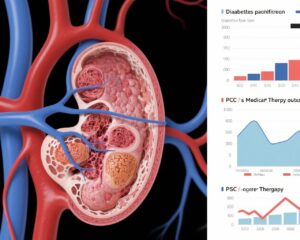Study Background and Disease Burden
Obesity remains a major global health challenge, contributing to comorbidities such as type 2 diabetes, hypertension, dyslipidaemia, and obstructive sleep apnea, which collectively impair quality of life and increase cardiovascular risks. Bariatric surgery is the most effective long-term weight loss intervention for severe obesity, improving metabolic outcomes and reducing mortality. Among surgical options, Roux-en-Y gastric bypass (RYGB) is a well-established procedure with durable efficacy. Since 2007, single-anastomosis duodeno-ileal bypass with sleeve gastrectomy (SADI-S) has emerged as a promising alternative potentially offering comparable or improved results with simpler technique. However, robust comparative data on efficacy and safety remain limited. The SADISLEEVE trial was designed to address this gap by directly comparing SADI-S with RYGB in a large French cohort at 2 years follow-up.
Study Design
This was a multicentre, open-label, individually randomized superiority trial conducted across 22 bariatric institutions in France, predominantly public academic hospitals. Eligible participants were adults with body mass index (BMI) ≥40 kg/m2 or ≥35 kg/m2 with obesity-related comorbidities including type 2 diabetes, hypertension, dyslipidaemia, sleep apnea, or osteoarthritis. Patients could be undergoing primary surgery or revision after sleeve gastrectomy, but those with prior bariatric surgery other than sleeve gastrectomy, inflammatory bowel disease, type 1 diabetes, or untreated Helicobacter pylori infection were excluded. Stratified randomization (1:1) balanced centers, prior sleeve gastrectomy failure, and presence of type 2 diabetes.
The primary endpoint was percentage excess weight loss (%EWL) at 2 years, calculated as ((weight at 2 years – initial weight) / (initial weight – ideal weight)) × 100. Secondary endpoints included safety outcomes categorized by surgical complications and adverse events.
Key Findings
Between November 8, 2018 and September 29, 2021, 381 patients were randomized (190 to SADI-S, 191 to RYGB). Participants had mean age 44.4 years, mean BMI 46.2 kg/m2, with 70% female and 21% having prior sleeve gastrectomy. Follow-up retention was 88% at 2 years.
Weight loss was significantly superior in the SADI-S group with mean %EWL of 76.0% (SD 26.7) versus 68.1% (SD 28.7) in RYGB (mean difference -6.72%, 95% CI -12.64 to -0.80; p=0.026), confirming SADI-S superiority. Missing primary outcomes occurred in 20% of patients but were balanced and not statistically different between groups.
Regarding safety, serious adverse events related to surgery numbered 40 in the SADI-S group—3 anastomotic leaks and 8 severe diarrhea cases—and 35 in the RYGB group featuring 5 internal hernias and 5 severe abdominal pain events (2 requiring diagnostic laparoscopy). Overall, both procedures displayed comparable complication rates with distinctive patterns of adverse events.
Expert Commentary
The SADISLEEVE trial provides robust evidence supporting the clinical utility of SADI-S as a bariatric surgery option with superior weight loss efficacy compared to RYGB at 2 years, without increasing serious complications. These findings align with previous smaller studies and reinforce the physiological rationale that SADI-S, combining restrictive and malabsorptive mechanisms via a single anastomosis, may optimize metabolic improvements. However, long-term data beyond two years remain necessary to assess durability and late complications. The slightly higher incidence of diarrhea post-SADI-S warrants attentive nutritional management. From a surgical perspective, the simpler single-anastomosis technique could reduce operative time and technical complexity, although risks such as anastomotic leaks need continued vigilance.
Limitations include the open-label design which may introduce detection bias, and the relatively short follow-up period for bariatric outcomes. Generalizability is strengthened by including patients after sleeve gastrectomy failure, reflecting real-world practice. Future research should also evaluate quality-of-life metrics and metabolic parameters in detail to further inform personalized surgical choices.
Conclusion
The SADISLEEVE trial demonstrates that SADI-S is superior to RYGB in achieving weight loss at 2 years, with a similar safety profile, supporting its increasing adoption in bariatric surgery centers. Careful surgical selection and post-operative management remain essential to optimize outcomes. These findings have implications for clinical decision-making and guideline updates in obesity management, highlighting SADI-S as a formidable alternative to RYGB. Ongoing long-term follow-up and broader metabolic assessments are needed to fully establish its comparative advantages and durability.
References
- Robert M, Poghosyan T, Romain-Scelle N, et al; SADISLEEVE Collaborative Group. Efficacy and safety of single-anastomosis duodeno-ileal bypass with sleeve gastrectomy versus Roux-en-Y gastric bypass in France (SADISLEEVE): results of a randomised, open-label, superiority trial at 2 years of follow-up. Lancet. 2025;406(10505):846-859. doi:10.1016/S0140-6736(25)01070-0.
- Angrisani L, Santonicola A, Iovino P, et al. Bariatric Surgery Worldwide 2013. Obes Surg. 2015;25(10):1822-1832. doi:10.1007/s11695-015-1660-3.
- Patel JA, Moncrieffe A, Batterham RL. Recent Advances in Bariatric Surgery: The Role of SADI-S. Curr Obes Rep. 2020;9(3):289-295. doi:10.1007/s13679-020-00400-3.



